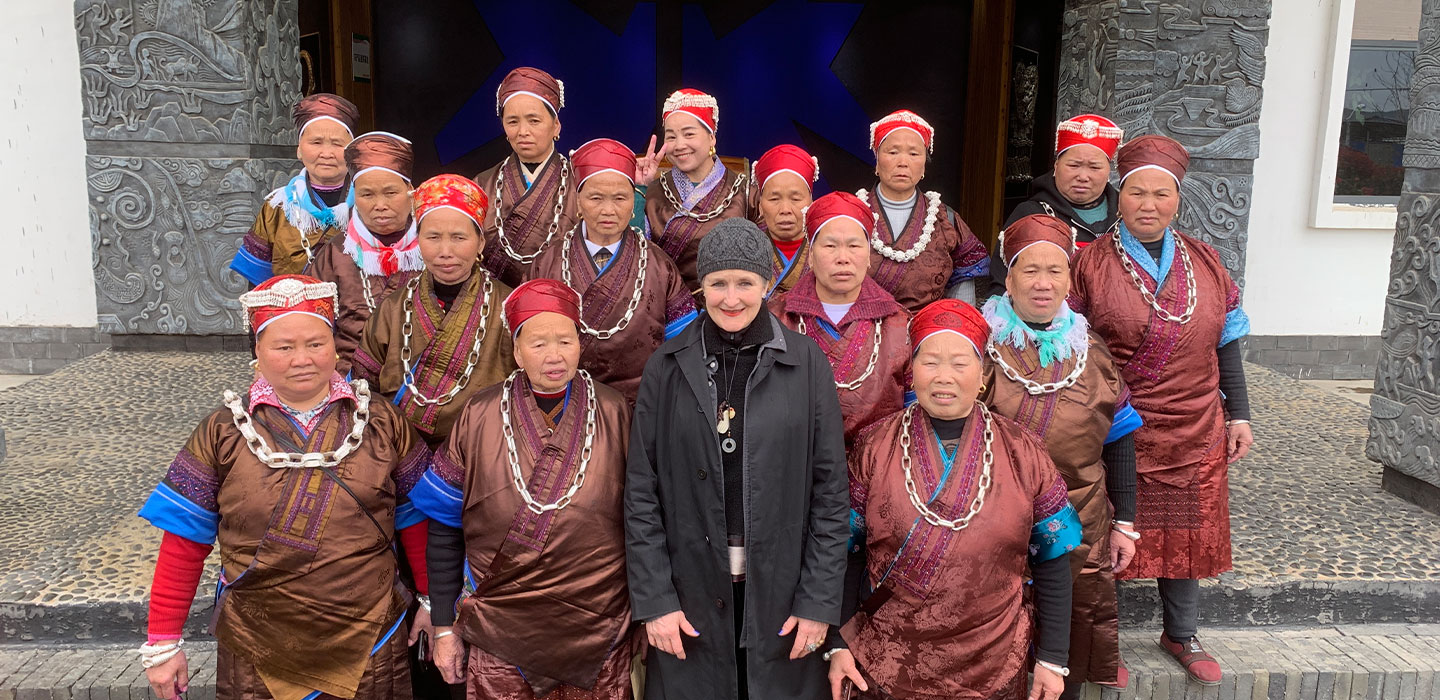Jehanne de Biolley是一位出生於比利時魯汶的珠寶設計師,她在倫敦學習了亞洲藝術史,然後在北京工作和生活了30年。
把自己的才華轉向時裝設計後,她來到中國南方學習苗族人的生活方式。
苗族人生活在山間,他們的文化是與歷史聯繫在一起的。他們精緻的頭飾和其他可穿戴的一切都是他們的文化遺產。
我在一開始問Jehanne,是不是苗族的珠寶吸引她第一次來到這個迷人的民族?
實際上,這不僅僅是吸引我到苗族的原因,而是讓我留在中國並對中國著迷的原因。因為這是一種獨特的珠寶製作方式,是苗族傳統的一部分。所有的叮噹作響的物件和所有微小的元素都連接在金屬扣上,並隨著佩戴者的動作而擺動,所以它們非常漂亮。我的中文名字叫「翠翠」,「翠」和中國珠寶的製作有關,它是以翠鳥命名的,翠鳥的羽毛是製作中國傳統珠寶的材料。
你在北京的時裝秀很大程度上是在向苗族人民和他們的文化致敬。你是如何開始創建這個系列的?從這一點出發,貫穿不同作品的主線是什麼?
當我創造一個系列時,我做的第一件事,是對這個系列做白日夢,我想像我將要描述的是什麼,我把我的設計看作是一個故事,一個遊記。因此,我讀了很多書,我研究了歷史和文化。當然,我也旅行,我的第一站總是當地的市集。
我是一個市集狂人。當我開始發掘這個主題的深度時,我就在想我怎麼把發現的所有東西納入一個系列?於是我決定選擇「太陽和月亮」作為主題,因為太陽和月亮可以解釋很多東西。它談到了珠寶、銀和金,它談到了正在建造的房子,以及大自然如何用白天和黑夜來建構自己。因此,這成為我的系列的象徵。
Jehanne,你來自比利時,這個國家擁有偉大的文化,特別是在紡織品方面,出現了像Raf Simons、Diane Von Furstenberg、Dries van Noten這樣的設計師。當你了解比利時的文化,並將其與你看到的苗族人的工藝進行比較時,你是如何體驗這兩種文化的?
首先,苗族刺繡的質素在很多情況下是我們所說的 「高級時裝」水平。但看看像Yves Saint Lauren、Etro、Ann Demeulemeester這樣的人已經從非物質遺產中獲得了如此多的靈感。他們這樣做的原因,正是因為他們被迷住了,受到了啓發。因此,在時尚界,去看看異國情調是一件非常自然的事情,這絕對是一個偉大的靈感來源。
值得慶幸的是,苗族文化在一定程度上得益於像你這樣的人,才得以生存和發展。但它與由創新驅動的現代21世紀有什麼樣的關係?
我看到的是,苗族人在「慢發展」方面走得很遠。他們珍視自己的傳統,珍視自己的生活方式,在任何時刻都能進行慶祝。是的,一方面世界變得越來越快,越來越創新。但也有一些人希望擁有不同的生活質素。我們向苗族婦女預訂繡品,請她們刺繡,給了她們一個機會,一個選擇,不用去大城市做非常艱苦的工作,而是留在離家和家庭近的地方謀生。所有像這樣的項目,都是在中國各地進行的全國扶貧工作的一部分。這是一個非常小的工作,但我非常自豪能夠參與這樣的項目,因為每一種努力都很重要。
非常感謝你,Jehanne。在我們的下一個影片中,我們將繼續探索你在苗族的旅程,我們將特別關注一下性別方面的話題。
接下來Jehanne de Biolley將向我們講述她在迷人的旅行中遇到的苗族人。
James Chau
Jehanne de Biolley is a jewelry designer, born in Leuven in Belgium, studying Asian history of art in London, and working and living in Beijing for 30 years.
She’s turned her talent to fashion design, traveling to southern China to learn the lifestyles of the Miao people.
The Miao live among the mountains where their culture is a living link to history, including their exquisite headdress and other wearable heritage.
I began asking Jehanne whether jewelry is what drew her first to this fascinating community?
Jehanne de Biolley
It's actually not what drew me to the Miao, but what took me to stay in and still be fascinated about China. Because it is such a unique way of making jewelry which is part of the Miao tradition with all the little dingle dangles and all those tiny elements which are attached on springs, and move with the movement of the wearer. So it's very beautiful. My Chinese name, Cui Cui, is also for jewelry making, it's named after the Kingfisher which adorn some of the jewelry of Chinese traditional clothing,
James Chau
Your fashion show in Beijing was very much a tribute to the Miao people and their culture. How did you begin to create a collection? And then from that point, what was the thread that ran through the different pieces?
Jehanne de Biolley
When I create a collection, the first thing I do I suppose is I daydream about the collection, and I imagine what it is that I am going to describe and because I see my design as a storytelling, as a travelogue. So I read a lot of books, I researched the history, the culture, and I travel of course, and the first stop always is the local markets. I'm just a market freak. So once I started discovering the depth of the subject, I thought, wow, how am I going to bring it all into one collection? I decided to go for 'sun and moon' [as the theme], and sun and moon can explain so many things. It talks about jewelry, silver and gold, it talks about houses that are being built, and how nature organizes itself with daylight and nighttime. So, that became the symbol for my collection.
James Chau
Jehanne, you're from a magnificent culture yourself in Belgium, particularly for textiles. Designers like Raf Simons, Diane Von Furstenber, Dries van Noten... when you look at the Belgian culture, and you compare it with the craftsmanship that you see with the Miao people, how do they measure up?
Jehanne de Biolley
First of all, the quality of the Miao embroidery is what we would call "haute couture" level in many cases. But look at people like Yves Saint Lauren, Etro, Ann Delemeumeester have been so inspired by intangible heritage. And they didn't do it for other reason than just because they were mesmerized and inspired. So it's a very natural thing in fashion to go and look at at exoticism, and this is a definitely a great source of inspiration.
James Chau
Thankfully, the miao culture is alive and thriving in part thanks to people like you. But what relevance does it have any modern 21st century that's driven by innovation?
Jehanne de Biolley
I see that the Miao people are very much ahead of the "slow movement". They cherish their tradition, they cherish their lifestyle, and they celebrate at any possible moment. It's this idea that yes, on the one hand, the world is becoming faster and more innovative. But there's also people who want to have a different quality of life. By placing orders of embroidery and embroidered items to women, it gives them an opportunity, a choice, to not go to the big cities to get the very hard jobs, but to stay close to the home and a family and make a living. So all of this is part of a national effort to alleviate poverty around China. It's a project I'm so proud to be a part of in a very small way, but every way counts.
James Chau
Thank you very much, Jehanne, and in our next video we'll continue exploring your journey with the Miao people, and especially look at the gender aspect. Thank you very much. Coming up Jehanne de Biolley tells us about the Miao people she met on her fascinating travels. Next on The China Current.

